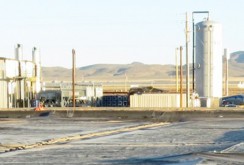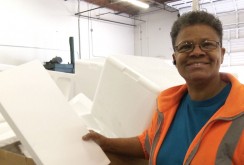
A Dirty Business: What Ever Happened to Jimmy Hoffa?
It’s been 39 years since Teamster boss Jimmy Hoffa disappeared. On every anniversary of Hoffa’s disappearance, a new theory emerges about the location of his final remains. Here are just a few of them:
• Hoffa’s body was put in a 55-gallon steel drum, and carried off in a truck, then buried on the grounds of a toxic waste site in New Jersey.
• His body was mixed into the concrete that was used to construct the New York Giants' football stadium in East Rutherford, N.J.
• He was entombed in the concrete foundation of a public works garage in Cadillac, Mich.
• Another rumor places him under the helipad of the Sheraton Savannah Resort Hotel, which used to be run by the Teamsters.
What does Jimmy Hoffa’s disappearance have to do with the state of garbage in America? Garbage is a real business. Tony Soprano as the Italian-American Mafioso lording over the junk business isn’t just mythological fodder for cable TV. The Mafia did rule over the garbage industry for almost a century.
In New York, Nicholas A. Rattenni was not only the father of Alfred (“Nick Jr.”) Rattenni, but a man of notorious reputation, and widely considered to be the “czar” of the Westchester County garbage carting industry, controlling 90 percent of the county’s private garbage-hauling operations. Rattenni was also reputed to be a lieutenant in the Genovese family.
The Genovese family expanded their close-fisted reign over the garbage industry and ventured into new territories: Upstate New York in Rockland and Orange counties; into New Jersey and Connecticut; and eventually into Florida. Investigations of the Genovese family activities going back to 1957 indicate that their operations included numerous organized crime connections; control of the unions transporting garbage; the use of force, coercion and murder; the bribery and coercion of elected public officials; and bid-rigging and monopoly tactics to inflate the price of hauling contracts.
Even into the late 1980s, high-level government investigations and top-tier news coverage indicated the waste industry was still very much a Mafia-driven affair in love with the profits derived from racketeering, corruption, and price-fixing associated with the hauling and disposal of garbage.
In his New York Times article, “The Garbage Game,” Ralph Blumenthal reported that “Despite more than 30 years of investigations and prosecutions, the private carting industry in the New York City area, New Jersey and parts of Florida remains controlled by organized crime.”
Beginning of the end
There is every reason to suggest that government intervention and subsequent investigations escalated only because so many witnesses reported that the toxic waste materials being unlawfully dumped in landfills were beginning to have an impact on public safety.
For example, much of the toxic waste dumped into the Penaluna Landfill in Warwick, N.Y., posed a threat to nearby Greenwood Lake, which is a major water supply to nearly 1 million people. Local government officials who were on the take — and there were many — would have allowed the Genovese family to reign over garbage indefinitely if the gangsters weren’t so sloppy and increasingly dangerous. Their unlawful disposal of hazardous waste had now grown to become known as “poisoning the public for profit.”
It wasn’t until 2013 that the Protection of the Environment Operations Amendment (Illegal Waste Disposal) Act amended the Protection of the Environment Operations Act of 1997 to more effectively deal with illegal waste disposal and fraud. Why did they wait so long to create legislative protection?
The private carting industry — which is the combined forces of the garbage handlers and the garbage haulers, otherwise known as teamsters — has long been known as a cartel controlled by organized crime. Its underworld strong-arm tactics, comprising coercion, intimidation and murder, discourages anyone from complaining too loudly and blocks legitimate new companies from entering the business. (For more details on organized crime’s involvement in the waste hauling industry, click here).
And why should anyone complain? The Genovese are good business people; to some extent they’ve standardized the business, providing consistent service from hauler to hauler and inexpensive processing across the board. Besides, who wants to get their hands dirty in this messy business of garbage?
Back to Jimmy
If you consider that the Teamsters haul the garbage, then we can circle right back to Teamster boss Jimmy Hoffa and all others who suffer the misfortune of falling into disfavor with the Genovese family and get whacked.
Although Hoffa was declared legally dead in 1982, his case remains open. Every time some low-level thug is released from prison and claims to know the whereabouts of Hoffa’s body, federal investigative teams go on a highly publicized and very expensive wild goose chase. The feds have been known to raze barns, dig-up people’s yards and tear apart homes, always coming up empty-handed. Apparently, no one stops to think that low-level thugs coming out of prison have few job opportunities and that perhaps writing a fictitious tell-all book about the whereabouts of Jimmy Hoffa and getting a movie deal is the best they can do to make some quick cash.
There are many reasons to suggest that law enforcement ought to stop looking for Hoffa’s body, assuming there is a body left to be found. He was also alleged to have been ground up at a meat processing plant and then dumped in a Florida swamp or disintegrated at a fat-rendering plant. One report even suggests he skipped off to Brazil with a go-go dancer.
Even today, a special agent at the FBI’s Detroit field office is still assigned the Hoffa case, and the investigation has generated more than 16,000 pages of documents gathered from interviews, wiretaps and surveillance. Whether Hoffa’s body is buried beneath the the old Giants Stadium or he’s in the Riverbend Landfill in McMinnville, Ore., no one may ever know.
It’s an enormous expense to the American taxpayers to pay for federal teams to conduct complicated investigations and orchestrated searches, complete with forensics teams and on-site crime labs. And while the federal government has spent millions looking for Hoffa’s remains, you have to wonder why they don’t spend nearly as much doing a full-scale investigation into the dirty business of garbage.












